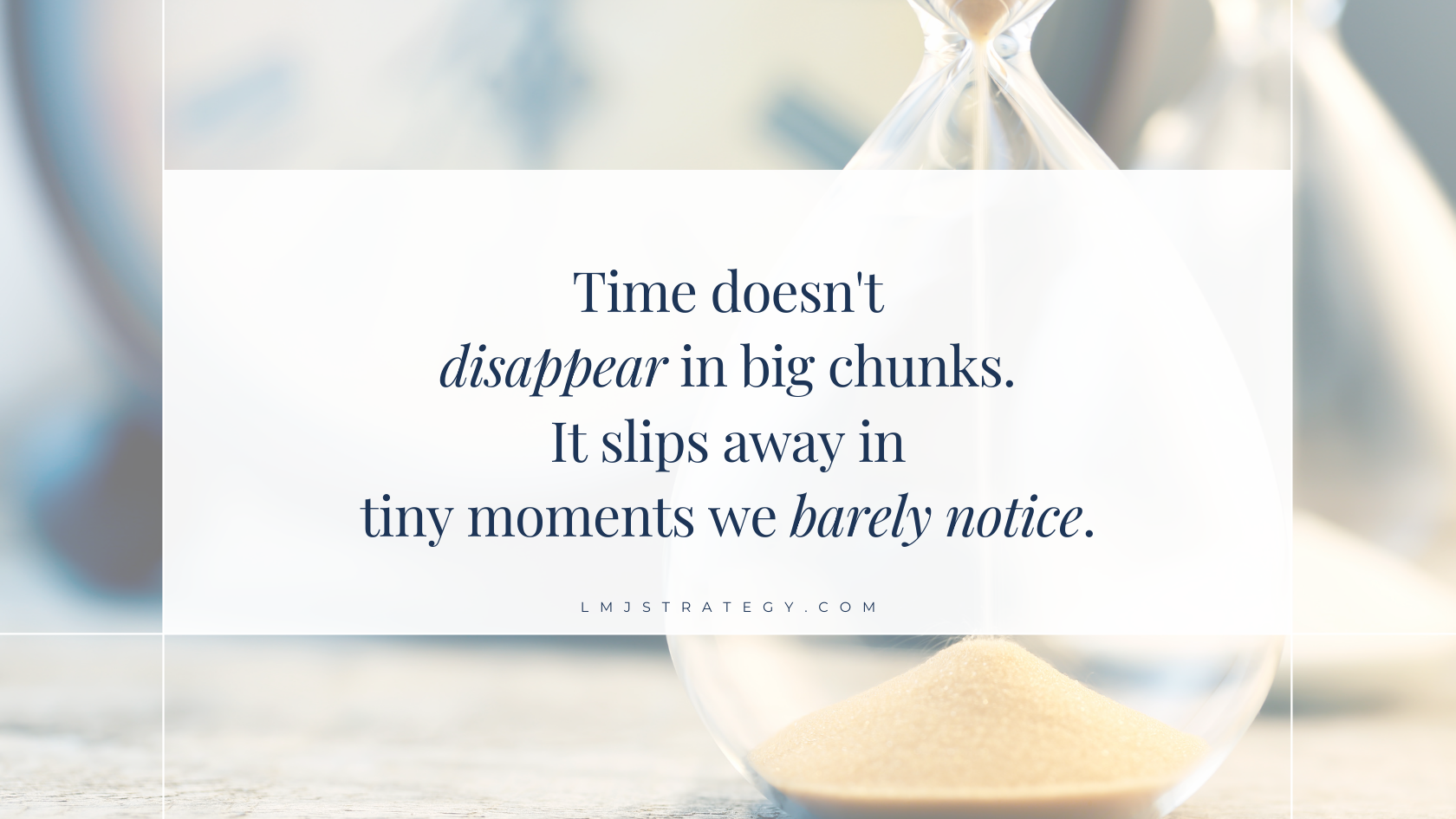As a small business owner, I used to think I had a solid grasp on how I spent my working hours. After all, I was the one doing the work, right? But when I started my first time audit back in 2018, using nothing more than a paper planner and a highlighter, I discovered something surprising. Those “quick” email responses and “just one more edit” moments weren’t just small interruptions. They were secretly draining my productivity.
Why Small Business Owners Need a Time Audit
Time doesn’t disappear in big chunks. It slips away in tiny moments we barely notice.
My first time audit taught me this lesson in an unexpected way. On day one, I noticed something interesting: I was being hyper-productive, far more than usual. Why? Because I knew I was tracking my time, I was subconsciously trying to create an “impressive” log of my day.
This wasn’t honest or helpful. I needed to see my real work patterns, not an idealized version of my productivity. That’s when I realized starting with a single day of tracking wouldn’t give me accurate insights. To uncover genuine patterns, I needed to track for a full week. This longer timeframe allowed me to fall back into my natural routines and spot my actual time management patterns.
According to recent Harvard Business Review research, 76% of professionals feel drained after days packed with meetings, highlighting why it’s crucial to audit and optimize how we spend our working hours.
My biggest discovery through this process? I was treating every email and chat message as urgent, responding immediately to make people feel heard and valued. While the intention was good, this habit was fracturing my focus and diminishing my productivity.
Time Tracking Methods That Actually Work
My approach to time tracking has evolved significantly since that first paper-and-highlighter audit in 2018. What started as a detailed log of every minute has transformed into something more sustainable and intuitive. Today, I use what I call a “rolling time audit” – a mindful awareness of how I’m spending my time, supported by digital tools when I need more clarity.
For daily operations, I create end-of-week reports to track progress on work tasks. Tools like ClickUp’s daily summary feature help streamline this process. When I notice myself getting distracted – like that time I spent 45 minutes organizing my Google Drive folders instead of actually working on the files inside them, I make note of it and adjust my mindset, and calendar, accordingly. Because let’s be honest, most of those emails can wait until my designated email time.

kucCreating a Sustainable Time Management System
The key to effective time management isn’t about squeezing more tasks into your day. It’s about creating realistic, sustainable systems that work with your natural rhythms.
Here’s how I structure my day:
Core Working Hours: 8:30 AM to 2:45 PM
Why these specific hours? They align with my children’s school schedule, allowing time for morning transitions and afternoon pickup. This isn’t just about maximizing work hours – it’s about creating boundaries that support both business and family life.
My Daily Block Structure
- 8:30-9:00 AM: Internal administrative tasks and social media engagement
- 9:00-1:00 PM: Client work (broken into project-specific blocks)
- 1:00-2:45 PM: Internal work (content creation and client acquisition)
The Power of Flexible Blocks
Within my client work block (9:00-1:00), I maintain flexibility. Some days might include:
- Project A: 9:00-11:00
- Project B: 11:00-12:00
- Client meeting: 12:00-1:00
Other days might look completely different, depending on deadlines and priorities. The key is having a framework that can adapt to changing needs while maintaining overall structure.
Weekly Planning: The Secret to Staying on Track
Every Monday morning during my administrative block, I plan my entire week. But here’s the real game-changer – my Friday afternoon review sessions. Think of it as a weekly “reality check” for your time management system.
During these Friday reviews, I look at three key areas:
- Approaching deadlines: What’s coming up, and am I on track?
- Task completion: Did I finish what I planned, or am I somehow 10 tasks behind on a project? (It happens!)
- Weekly KPIs: Did my actions align with my business goals?
This weekly check-in helps me spot patterns. For instance, if I constantly find myself behind on certain types of tasks, it might mean I’m not blocking enough time for them. Or maybe I’m being a bit too optimistic about how many Google Drive folders I can organize in one sitting (kidding – mostly).
Dealing with Unexpected Situations
Recently, I faced a challenging situation that tested my time management system. I was coordinating with multiple teachers and administrators about a school issue, which meant frequent email communications. At first, I found myself refreshing my email constantly – you know, just in case the principal replied in the last 30 seconds.
By lunchtime, I realized this wasn’t sustainable. Here’s what I did:
- Closed all email platforms
- Turned off phone notifications (keeping my smart watch on for truly urgent calls)
- Used the Pomodoro method to focus on work during set periods
- Checked emails only during designated breaks
This experience reinforced something important: having both long-term systems and emergency strategies is crucial for maintaining productivity.
Building Your Time Management Foundation
The beauty of time audits and management systems is that they’re not one-size-fits-all. My system works for me because it’s built around my specific needs – school schedules, ADHD management, and client deadlines. Your system needs to reflect your reality.
I’ve developed two types of strategies that work together:
Long-Term Sustainable Systems
- Set working hours that align with your life (mine are 8:30-2:45)
- Time blocking for focused client work
- Task management software for deadline tracking
- Regular system audits to check for better tools or methods
Emergency Toolkit (for those “everything is happening at once” days):
- Pomodoro method for deep focus
- Strategic notification management
- Quick reset techniques when focus wanders
The key is knowing when to use each approach.
Some days flow perfectly within your structured blocks. Other days? Well, let’s just say I’m grateful for my emergency toolkit.
Taking Action: Your First Time Audit
Ready to start your own time audit? Here’s how to begin:
- Start With a Full Week Don’t make my rookie mistake of trying to create the “perfect” tracked day. You want real data, not an idealized version of your productivity. Track a full week to see your actual patterns emerge.
- Choose Your Method Whether you prefer digital tools like ClickUp or a simple paper planner, pick what feels natural. I started with paper and highlighters before moving to digital solutions. There’s no wrong choice – it’s about what works for you.
- Review and Adjust Use your Friday afternoons (or whatever time works for you) to review your patterns:
- Are you allocating enough time for tasks?
- Where are your biggest time drains?
- What patterns emerge in your productive periods?

Measuring Success and Making Adjustments
Success in time management isn’t about achieving perfect productivity every day. It’s about creating a sustainable rhythm that works for your business and life. When I review my time management system, I look for a few key indicators:
- Am I meeting deadlines without last-minute rushes?
- Do I feel present during my work hours rather than scattered?
- Can I confidently close my laptop at 2:45, knowing everything important is handled?
- Are my systems flexible enough to handle unexpected situations?
Remember, the goal isn’t perfection. It’s progress. Some weeks, you’ll nail every time block. Other weeks, you might need to rely more heavily on your emergency toolkit. Both scenarios are completely normal.
Moving Forward: Your Next Steps
Understanding where your time goes is just the first step. The real transformation happens when you use these insights to create systems that support your work style and business goals.
As workplace trends evolve in 2024, understanding and adapting your time management approach becomes increasingly important, especially for neurodivergent business owners.
If you’re feeling overwhelmed by the idea of conducting a time audit or creating sustainable systems, you’re not alone. Many of my clients initially felt the same way. That’s why I offer workflow optimization services specifically designed for small business owners who want to reclaim their time and reduce overwhelm.
Ready to Optimize Your Time?
Are you struggling to manage your time effectively? Let’s work together to create systems that work for your business. Through my workflow optimization services, we’ll identify your time drains and build sustainable solutions that match your working style.

